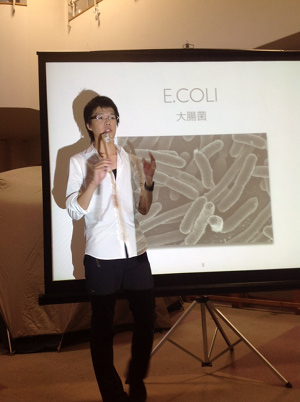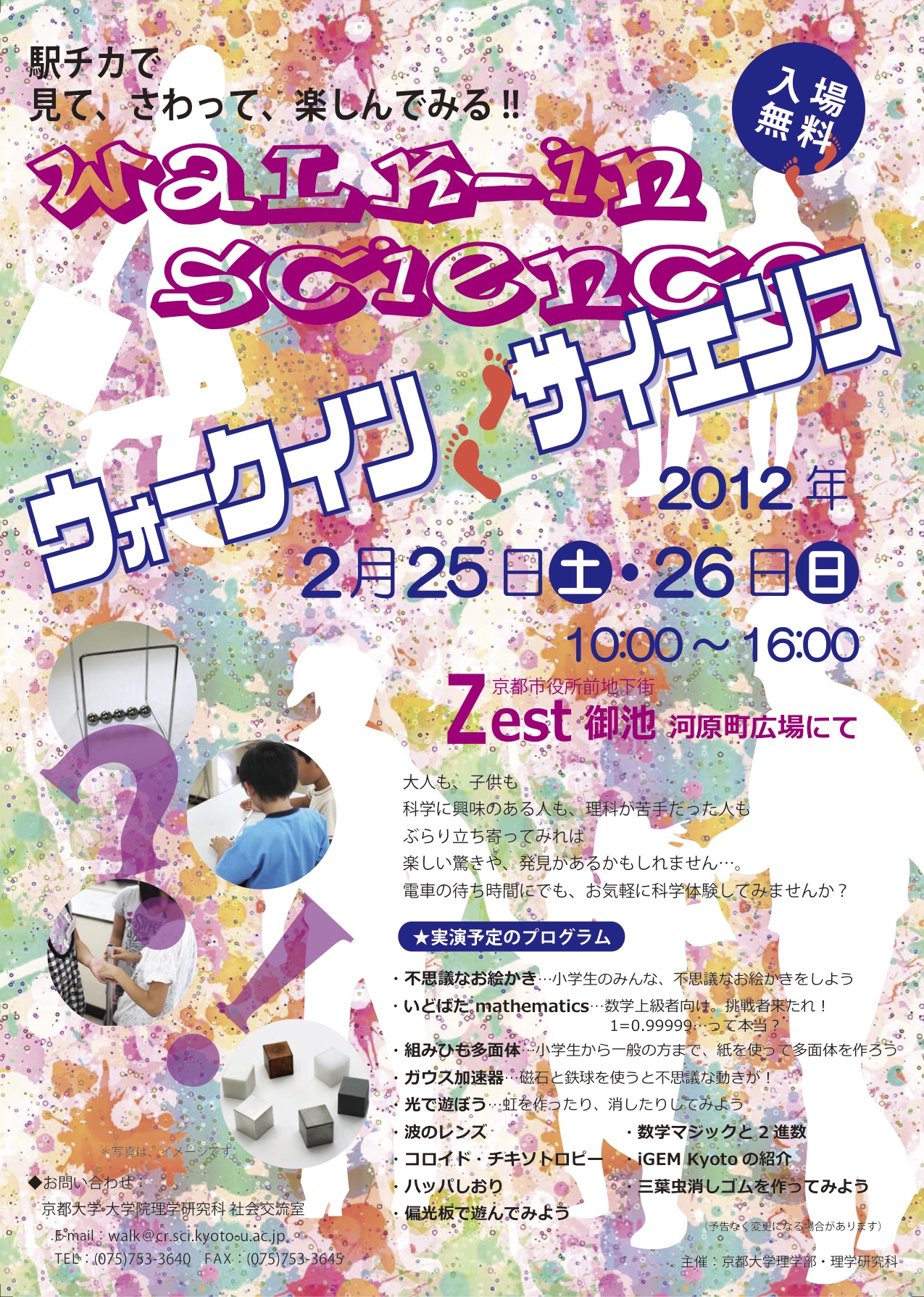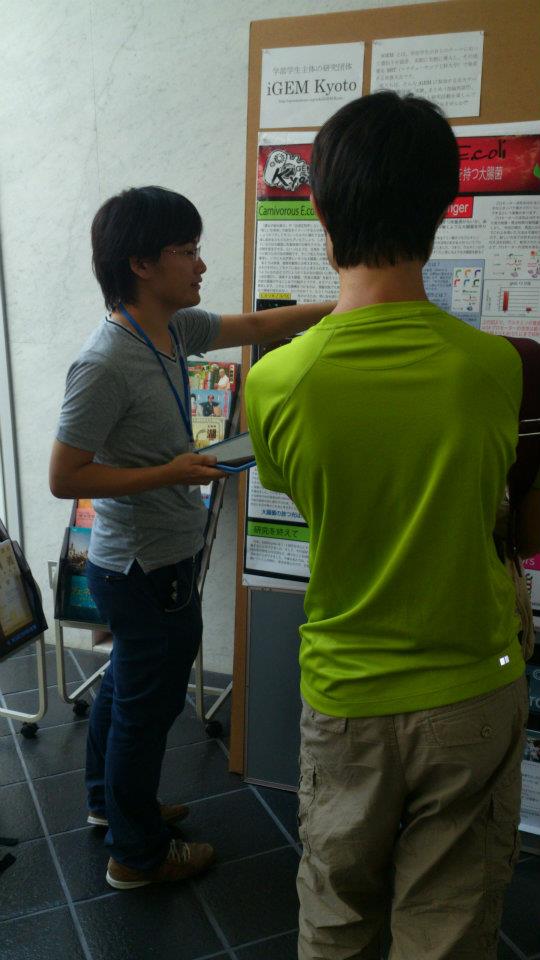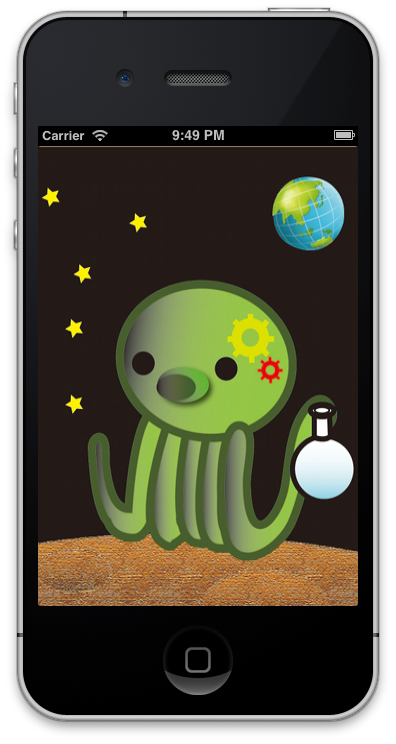Team:Kyoto/Consideration
From 2012.igem.org
(→Open Campus at Kyoto university) |
(→Presentation) |
||
| Line 60: | Line 60: | ||
==Presentation== | ==Presentation== | ||
| + | |||
| + | |||
| + | <br style="clear: both;" /> | ||
| + | |||
| + | |||
---- | ---- | ||
</div> | </div> | ||
Revision as of 12:50, 26 September 2012
Contents |
Consideration
This year, we implemented two main plans on "human practice".
The first project is that we created an iphone app to let many Japanese know synthetic biology. This is because some Japanese people seem to have a bad impression for gene recombination, so we want to modify this bias. In addition, the number of the japanese who know what gene recombination is is still small, so we would like to show how wonderful recombination is to them.
The second project is to introduce the synthetic biology to high school students, as we would like many high school students to participate in iGEM. This summer, we carried out lectures about gene recombination and biochemistry in "Seiryo festival" at Hibiya high school, furthermore we held a poster session in open campus of Kyoto university.
Due to the curriculum in our country, it is rather difficult for high school students to take part in iGEM undergraduate category, so we decided to tell them about the HS division and support students who are interested in it. There will probably be many teams from Japan in the next iGEM HS division.
Application
This year, we created an iPhone app named "iColi" that is aimed to let many Japanese know synthetic biology and bring it closer to the non-English speakers by presentation of an example of gene recombination. This application contains not only the example of gene recombination but also the list of gene and an award the teams won.
Education

We went to Hibiya high school and Horikawa high school, then we gave a short introduction on synthetic biology and iGEM, including the attractive points of synthetic biology, the ways of changing living things by reconstructing their genes and activities of other undergraduate iGEM teams.
In Japan, most high school student was not able to learn about synthetic biology and details of gene combination due to a regular curriculum of high school. This is why we decided to let them know how to conduct the experience, what synthetic biology is, and what iGEM is.
In addition, we met some eager junior high school students, so we added a brief explanation about biochemistry, especially genes, nucleotide, codon and the basic system of gene expression.
We used these slides in order to teach synthetic biology.
Team:Kyoto/Education
Walk in science

Kyoto university Academic day
Open Campus at Kyoto university

Tip-up
Presentation
Q1. Would any of your project ideas raise safety issues in terms of: researcher safety, public safety, or environmental safety?
We use the following creatures and genes.
・Creatures
- Arabidopsis thaliana
- Escherichia coli
・Genes
- tatABCD operon
- TAMO reductase
- torA signal
- pspA
- Kil
- FLOWER LOCUS T
- others in iGEM Parts Kit
FLOWER LOCUS T is derived from Arabidopsis thaliana and other all genes expect for iGEM Parts Kit are derived from E.coli. All experiments are conducted under the Biosafety level 1 control. All of rubbish containing recombinant E.coli is not carried out of our Lab before being sterilized. We always take care to lock the door of our Lab when there is no person so that the possibility that someone goes into our Lab and takes away recombinant cells is very low.
We are trained in applicable lab safety to ensure researcher safety and environmental safety. The researchers have also been trained in proper usage of chemicals and equipment. Some of the biological reagents and experiments necessary for the project needed safety measures. They were; Ethidium Bromide (EtBr), phenol, chloroform, 3,5-dinitrosalicylic acid, gas burner, ultra violet LED, polyacrylamide, 2-mercaptoethanol, PFA. Therefore, all researchers keep following rules when we use the chemicals or equipment above.
- EtBr (Ethidium bromide): EtBr is regarded as a mutagen, carcinogen or teratogen. Lab members were briefed on the possible effects of EtBr. During the experiments, we wore gloves. After use, the gloves and gel were separately disposed.
- Phenol and 3,5-Dinitrosalicylic Acid: Phenol and its vapors are corrosive to eyes, skin, and respiratory tract. 3,5-Dinitrosalicylic acid can cause serious irritation to eyes. These were handled under the draft chamber.
- Chloroform: Chloroform is a possible carcinogen. To avoid unnecessary exposure, this was also handled under the draft chamber.
- Gas Burner: We used gas burners and heated the air around the workspace to raise the temperature, thereby reducing contamination. Although the gas burner is a common combustion apparatus we are all familiar with, it can cause a massive disaster if used improperly. We made all-out efforts to keep all the flammable items away from the flame and not to pass behind a person who is using a gas burner.
- Ultra Violet LED: Ultra violet (UVB) is harmful to eyes. Hence, the LEDs were lit only inside the cardboard box and we only look at it to check if it is properly lit to avoid long exposure.
- polyacrylamide,2-mercaptoethanol:We used these reagents for Western Blotting. They are toxic even though they are necessary to check the expression of target proteins so we asked for advice on how we should store them and obeyed the rules of Kyoto University.
- PFA: This reagents are used to microscope E.coli by Confocal laser scanning microscopy. This is ususally stored in Prof.Agata’s Laboratory
Q2. Do any of the new BioBrick parts (or devices) that you made this year raise any safety issues?
- NO. Currently we have no BioBrick which raises any safety issues. The BioBricks we made this year are derived only from lab-safe strains of Arabidopsis thaliana and E.coli.
Q3. Is there a local biosafety group, committee, or review board at your institution?
Yes. We submitted the experiment plan to the Environment, Safety, and Health Organization, Kyoto Univ. (http://www.esho.kyoto-u.ac.jp/index.php) and were allowed to operate genetic modification of the bacteria under the Biosafety level 1(. Experiments were planned following the safety guidelines of the university (http://www.esho.kyoto-u.ac.jp/wp-content /uploads/2008/05/25_01.pdf). These guidelines are based on national laws and this includes several regulations on GMOs (http://www.bch.biodic.go.jp/hourei1.html). We carried out our experiments in the students-laboratory of the Graduate School of Science / Faculty of Science, Kyoto Univ, which has its own department for safety and environment. All of the lab members received training for PCR, culture of cells, miniprep and etc., the minimal genetical operations and use of autoclave.
Q4. Do you have any other ideas how to deal with safety issues that could be useful for future iGEM competitions? How could parts, devices and systems be made even safer through biosafety engineering?
IGEMers should set up a common clear biosafety regulation in iGEM competition and establish a systematic guideline of education about biosafety. This education should include information about biohazard and biotechnology risk assessment and risk analysis.
Backgrounds of iGEMers have become wider and wider, from high school students to graduate student in biology and from major in physics to major in molecular biology. For some students, iGEM is the first contact to genetic engineering and they have little knowledge of biohazard and importance of biosafety. Each iGEM teams, of course, teaches the knowledge to their members.However, a systematic education way of biosafety will help students to understand biosafety and to conduct their experiments more adequately.
From these reasons, we recommend that iGEM establish a systematic guideline of education about biosafety.
We work together with KAIT_Japan on issues of safety.
Cooperatively with KAIT_Japan, We iGEM Kyoto placed icons on our Wiki, which immediately enable you to see a risk of parts. The icons are as follows:
- Bio safety level 1:http://partsregistry.org/Image:Biosafety_Level1.png
- Bio safety level 2:http://partsregistry.org/Image:Biosafety_Level2.png
- Bio safety level 3:http://partsregistry.org/Image:Biosafety_Level3.png
- cases which affect biological community: http://partsregistry.org/Image:Biocenosis.png
- cases which affect the environment :http://partsregistry.org/Image:Environment.png
- cases which affect human bodies:http://partsregistry.org/Image:Humanbody.png
- cases which includes a certain risk because of mutations: http://partsregistry.org/Image:Mutation.png
- safe: http://partsregistry.org/Image:Safety.png
We thank all our advisors and Kyoto University especially Faculty of science from the bottom of our heart.
They give us some great advices.
Knut Woltjen
Center for iPS Cell Research and Application(CiRA). Kyoto University
Humihiko Satou
Graduate School of Biostudies. Kyoto University
Takayuki Kouchi
Graduate School of Biostudies. Kyoto University
Toru Matou & Masaru Kobayashi
Faculty/Graduate School of Agriculture
Takashi Endou
Faculty/Graduate School of Agriculture
Tan Inoue
Graduate School of Biostudies. Kyoto University
Attribution
Takashi Araki
[http://www.lif.kyoto-u.ac.jp/labs/plantdevbio/index.html Laboratory of Plant Deveropmental Biology]
- (c) 2007 Plant Developmental Biology, Graduate School of BIOSTUDIES, Kyoto-Univ.
He gave us Flower Locus T Plasmid.
Kojirou Takanashi
He gave us Arabidopsis thaliana.
Tokitaka Oyama
He gave us MilliQ and EtBr.
Ikuko Nishimura and Tomonori Takada
They gave us Arabidopsis thaliana and Syringe.
Toshiharu Shikanai
He gave us Arabidopsis thaliana.
Ikuhiko Nakase
He gave us Arabidopsis thaliana.
Makoto Kashima
He supervise our using confocal microscope and liquid nitrogen.
Wataru Shihoya
He supervise our purification of protein.
Tetsurou Okuno
He gave us Arabidopsis thaliana.
Kyoto University is our school and supported us.

Intergrated DNA Technologies (IDT), Japanese branch, Medical & Biological Laboratories Company (MBL)

File:MBLlogo.gif
CosmoBio supported us financially.

 "
"








